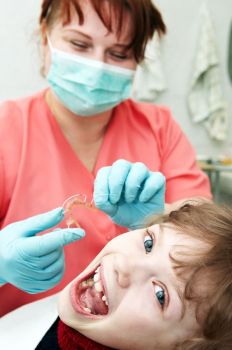Your orthodontist has recommended that your child consider Phase 1 treatment. You probably have some questions as to what is it and what you should expect.
What is Phase 1 treatment?
This is the first phase of a two-part orthodontic treatment. It is primarily used on patients from 7-10 years old. Also known as Interceptive treatment, it identifies those young patients who have some primary and some permanent teeth, who will benefit from jaw development before braces. It is ordinarily followed by Phase II treatment once all of the adult teeth have erupted.
What is the benefit of Phase 1 Treatment?
For many parents who have had Phase 1 orthodontic treatment recommended for their children, the initial question is why not simply wait until all of the permanent teeth are out before starting treatment?
The quick answer is that it is a preventative measure to mitigate severe problems in the future. The earlier treatment of misalignments and malocclusions will lead to more measurable and predictable results, as well as more control in the second phase of treatment (usually between 11-13 years old). It often translates to less invasive and more lasting future treatments.
Jaw structures in younger patients aren’t set, which allows your orthodontist to shape the jaw into an optimal alignment a lot more readily.
Earlier treatments can also help to stop abnormal tooth wear and jaw growth, and reduce chances of needing to have adult teeth removed later due to overcrowding. They can help children with protruding teeth to avoid tooth damage. Phase I treatment can also mean less time in braces during Phase II treatment.
Who does it benefit?
As we noted, younger patients often benefit from earlier adjustments, leading to consistent and better results with future treatments. In addition to helping develop both sets of jaws, early treatment also aligns them for a better bite. It can help with these types of “bad bites”:
- severe crowding
- openbite
- deep bite
- crossbite
- overjet (or large a overbite)
- underbite
Should Phase I be used for all children with malocclusions?
No. As we mentioned above, it is generally recommended to those younger patients who fall into those categories where early treatment will result in better outcomes. But development of teeth and jaws happens at different stages for children.
Some early developers might have all the permanent teeth in by nine or ten years old, whereas some children will be teenagers before they have all of their adult teeth.
Your orthodontist is trained to recognize the necessary stages of jaw development where orthodontic treatment will be most effective. The AAO recommends that children have an orthodontic consultation when they are seven years old as a precautionary measure to determine if future orthodontic treatment might be necessary.
Contact one of Orthodontic Associates’ friendly staff members today if you have concerns that your child might need Phase I treatment. One of our experienced doctors will happily address your questions at one of our nine convenient locations around Baltimore. At Orthodontic Associates, we look forward to making you smile!



